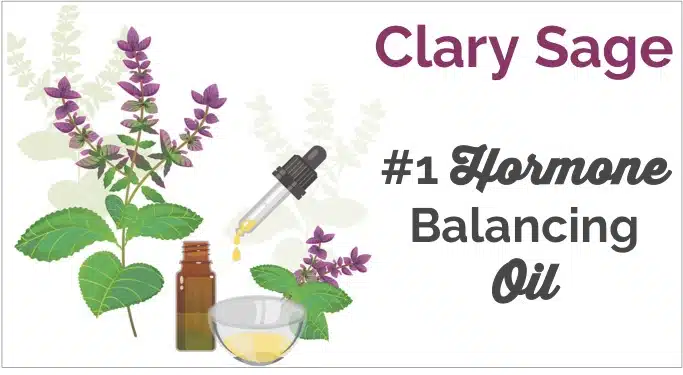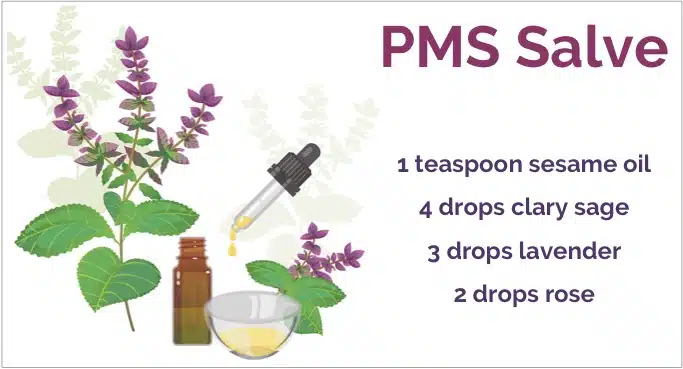Our guest post today is contributed by Dr Eric who is also the host of the Essential Oils Revolution starting on August 22nd. I hope you join it, it’s a brand-free event with top-notch content.
The medicinal use of clary sage dates back to the age of Rome and Greece. Officially named Salvia sclarea, it was used for eye conditions, to clear (clarify) the eyes, potentially with the mucilaginous seeds. In 1653, Dante Culpeper’s work Complete Herbal described clary sage as such:
“The seed put into the eyes clears them from motes, and such like things gotten within the lids to offend them, as also clears them from white and red spots on them. The mucilage of the seed made with water, and applied to tumours, or swellings, disperses and takes them away; as also draws forth splinters, thorns, or other things gotten into the flesh. The leaves used with vinegar, either by itself, or with a little honey, doth help boils, felons, and the hot inflammation that are gathered by their pains, if applied before it be grown too great… The juice of the herb put into ale or beer, and drank, brings down women’s courses, and expels the after-birth.”(1)
Centuries later, we still use clary sage oil in similar ways, particularly for its anti-inflammatory benefits and role in women’s health.
What is Clary Sage?
Primarily originating from the Mediterranean region, clary sage is a Salvia variant, which you may know from your ornamental perennial garden or from its cousin sage, which is used for both culinary and medicinal purposes. Salvia are part of the larger Lamiaceae distinction, the mint family, which is full of fragrant plants rich in essential oil and healing qualities.
Clary sage is used in both herb and essential oil form, and even the seeds have nutritional value. As with any herb or essential oil, where clary sage is grown, how and when it is harvested, and the parts of the plant used all play a part in the quality and components. (2)
Covered in spikes of flowers, fragrant, and grown as a perennial, it’s little wonder that the ancients found use for this favorite family of herbs!
Composition of Clary Sage
Clary sage essential oil is derived from the flowering tops and contains many components known for their anti-inflammatory and calming benefits, including linalool (a major component of lavender essential oil), linalyl acetate (excellent for anti-inflammatory benefits on skin), and a component called sclareol. The method of extraction may affect the components found in the essential oil, so always be aware of your source before using an oil therapeutically. (3)
Aside from anti-inflammatory abilities, clary sage is also known to be relaxing and antidepressant, antifungal, and antimicrobial. It is also an excellent antioxidant source, with a large portion of its composition coming from caryophyllene oxide, a powerful antioxidant that may even be implicated in fighting the effects of aging and prolonging life! (4, 5)
Another component, sclareol, has shown some promising things in lab tests. Over the last couple of decades but as recently as this year (2015), studies have emerged that analyze sclareol’s effect on cancer cells. With the caveat that these benefits occurred within the confines of lab cultures and dose adjustments, sclareol may have an impact on the way that cancer cells proliferate, and they could help to induce apoptosis (cancer cell death). (6, 7)
While this does not tell us how much potential sclareol has to directly treat cancer – and it’s exciting to think about where that could go one day! – it is a common thread that we see in many antioxidant-rich essential oils. This is especially interesting for clary sage, which also contains esters. Esters are commonly avoided in those who have cancer, as the phytoestrogen ability can, in theory, feed into cancer. With potential anti-cancer benefits built into clary sage, you have to wonder if it is meant to work as a whole package that ultimately delivers only benefits!
3 Clary Sage Oil Uses
Really, you can’t go wrong with antioxidants and anti-inflammatory effects. There are a few uses that stand out as particularly effective for clary sage, though, with plenty of research to back them up.
1. Antimicrobial skin protection — In 2015, researchers in Poland published results of their search for effective treatments for antibiotic resistant bacteria. When applied to resistant strains of the Staphylococcus bacteria, clary sage was able to kill the bacteria, where other antibiotics failed. (8)
Earlier, in 2012, a blend of essential oils was tested against Staphylococcus bacteria, as well as E. coli and the pervasive Candida fungus. A blend of lavender, clary sage, and ylang ylang was found to be synergistically effective against all three. (9)
2. Stress Relief — Aromatherapy is linked with relaxation and stress-relief in many of our minds, even before we become familiar with essential oils. I know that’s all I knew of them at first! But certain oils are more effective than others, and clary stage stands out. In fact, when a group of essential oils were tested for antidepressant abilities, clary sage showed far and away the most potential, indicating it as a potential stand-alone treatment thanks to dopamine regulation. (10)
3. Women’s Health — Clary sage is most commonly known as an herb and essential oil for women’s health issues, thanks to its esters and phytoestrogen ability, exhibiting benefits in all phases of life. Young women dealing with menstrual pain have found relief, even more so than what acetaminophen could provide. (11) Women with dysmenorrhea found similar relief. (12)
In childbirth, where pain is often exacerbated by anxiety and stress, clary sage and chamomile exhibit strong pain relieving results in a safe, easily administered manner. In fact, when a midwifery practice implemented the use of these oils both topically in a carrier oil and via diffusion, the use of pain-relieving opioids began to decrease significantly. (13)
Finally, as women reach menopausal years, the use of antidepressants begins to increase dramatically. Clary sage may help to ease this stressful transition of life, reducing cortisol levels and exhibiting and antidepressant-like effect (14)
For maximum effects, try blending clary sage with oils that have similar properties, like lavender and chamomile.
Magdalena’s note: Apply the essential oils on your womb, ovaries, behind your neck or at the bottom of your feet.
Resources:
- http://www.bibliomania.com/2/1/66/113/frameset.html
- http://pubget.com/articles/elasticsearch_show/0671f940-3eaa-4e28-80af-2502b3a89296
- http://www.tandfonline.com/doi/abs/10.1080/10412905.1999.9701074#.VbEjG_lVg_8
- http://pubget.com/articles/elasticsearch_show/24929006
- http://www.ncbi.nlm.nih.gov/pubmed/24835194
- http://www.ncbi.nlm.nih.gov/pubmed/10071073
- http://pubget.com/articles/elasticsearch_show/25672419
- http://www.ncbi.nlm.nih.gov/pubmed/25821423
- http://pubget.com/articles/elasticsearch_show/23157022
- http://www.ncbi.nlm.nih.gov/pubmed/20441789
- http://www.ncbi.nlm.nih.gov/pubmed/21949670,
- http://pubget.com/articles/elasticsearch_show/22435409
- http://www.ncbi.nlm.nih.gov/pubmed/11033651
- http://www.ncbi.nlm.nih.gov/pubmed/24802524


Thanks for this great information, i am training to be a holistic nurse and now a Natural Health Coach, and have learnt about essential oils. I have been using them, so healing, but one needs education about the precautions and side effects of each and also the blends. Hope morepractitioners embrace and learn about them.
the best #clary_sage_oil
check it >>>>> http://goo.gl/lWk2G2
I have cancer and am very interested on how to use clary sages do ther essential oils, I also have a urinary tract infection to top it off.
Thank you, BARBARA Stark
I am very interested in essential oils for healing cancer living in my body and urinary tract infection for healing.
[…] https://hormonesbalance.com/articles/clary-sage-oil-stress-relief-womens-health/ […]